Abstract
The only gastrin-dependent gastric endocrine cells are the fundic ECL cells. Excessive hypergastrinemia stimulates ECL cell proliferation in animals and man. The growth of other gastric endocrine cells is regulated by the gastric pH. Hypergastrinemia in man results in diffuse and linear hyperplasia of the ECL cells, while micronodular hyperplasia is correlated to the grade of corpus gastritis. ECL cell dysplasia and gastric carcinoids in man have been observed only in patients with gastrinoma as part of the MEN I syndrome and with pernicious anemia. Gastrin dependence of GI adenocarcinoma has not been established. Experimental findings may be explained by the presence of gastrin receptors and the role of gastrin as an autocrine growth factor. Epidemiological data do not support gastrin dependence of carcinoma of the stomach, the pancreas and the colon.
Full text
PDF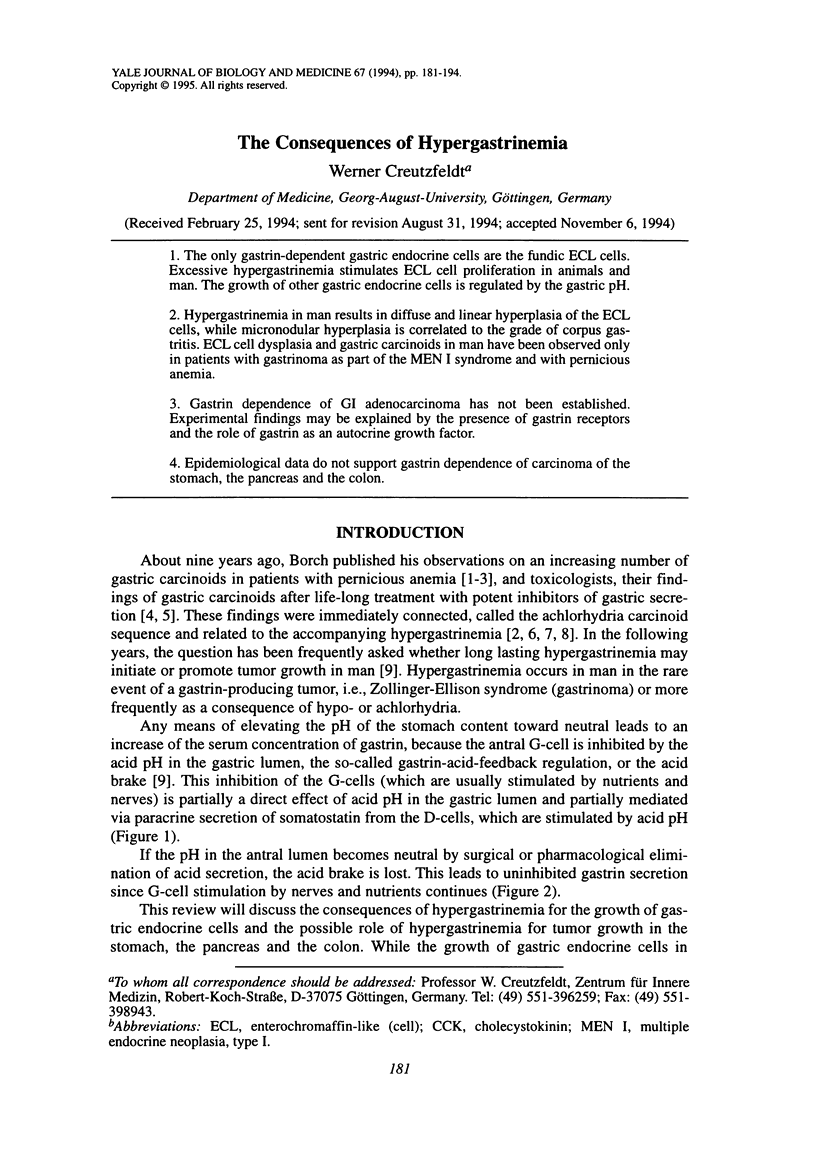
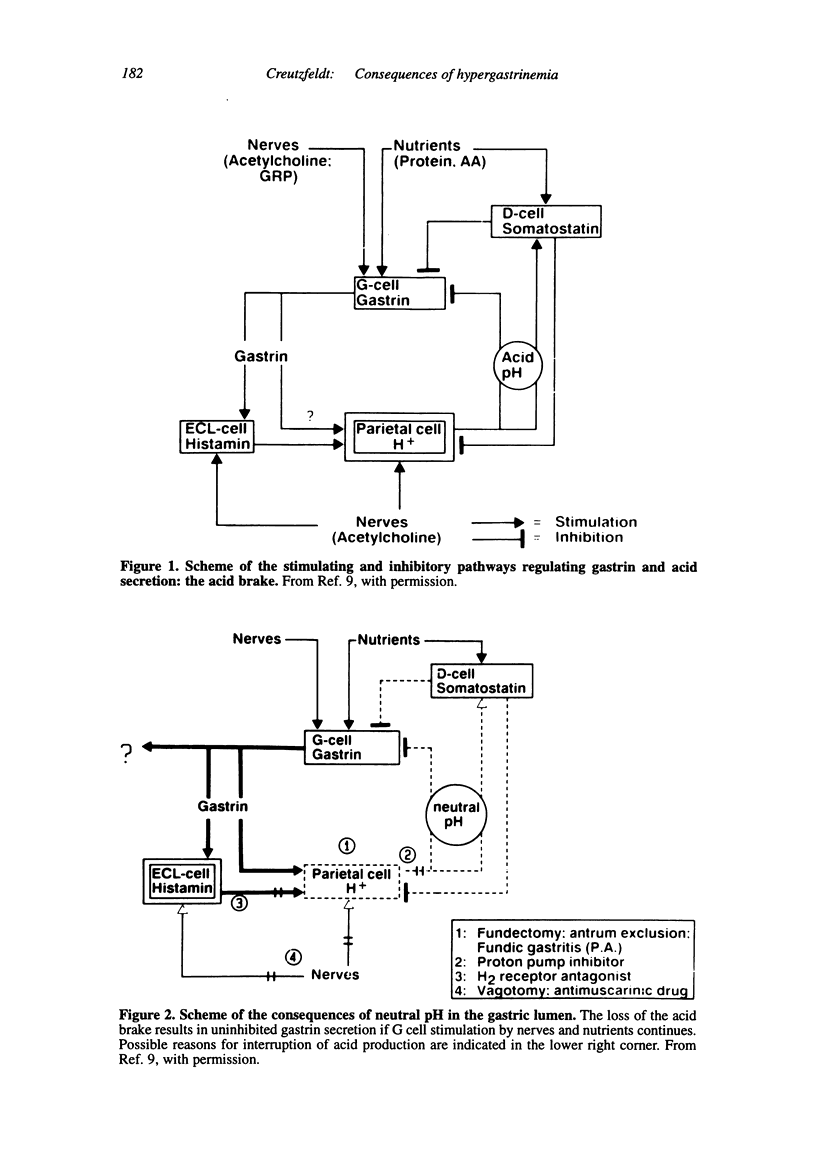
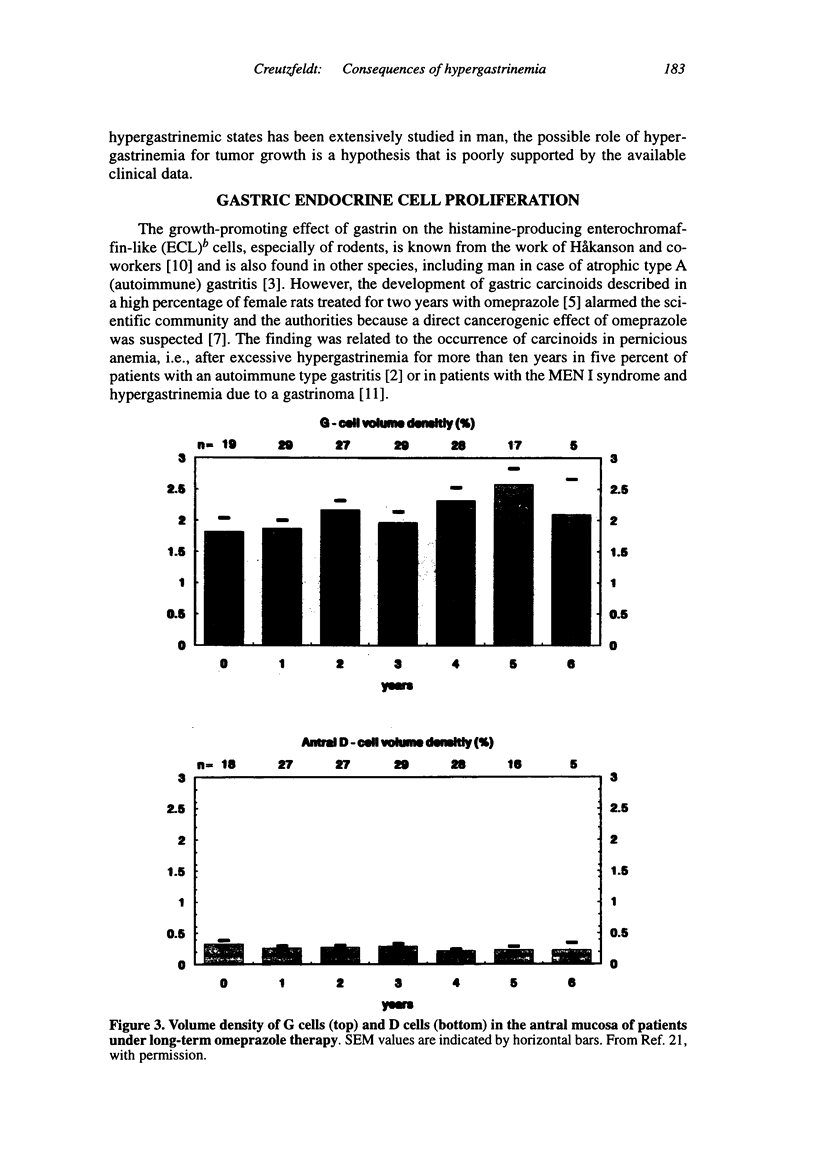
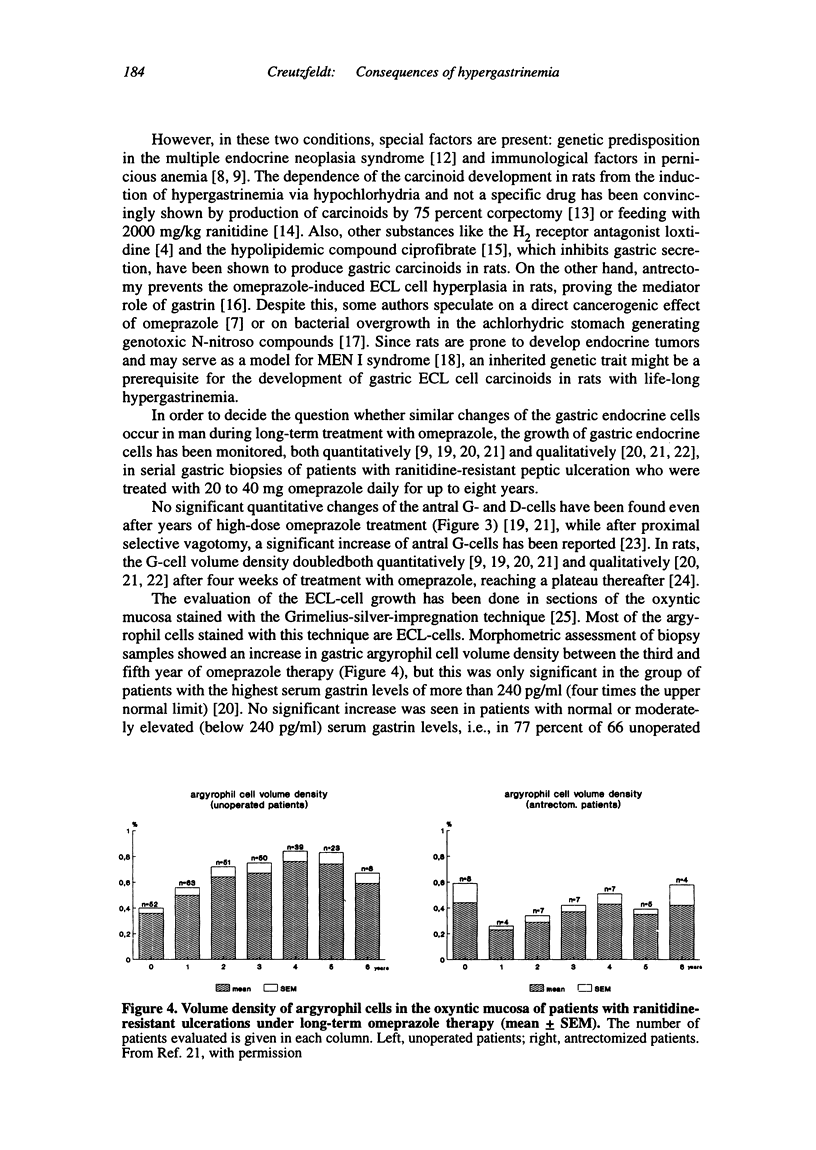
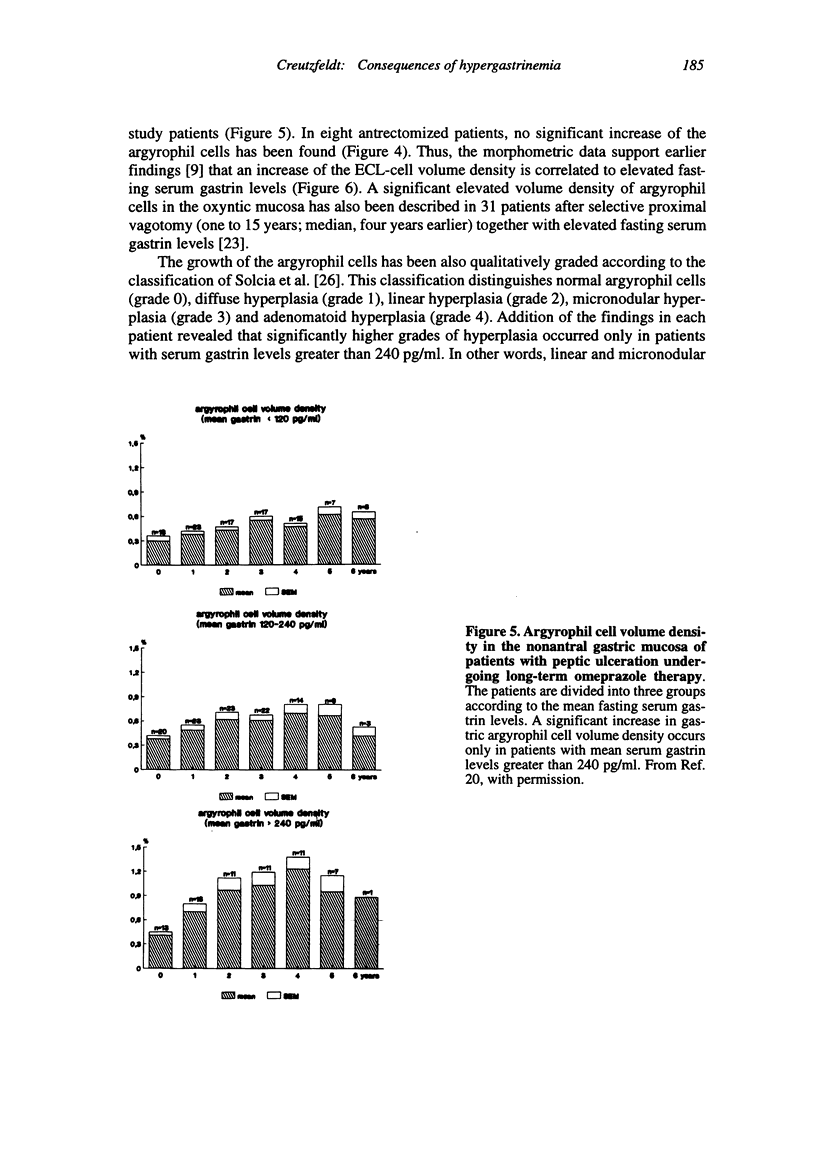
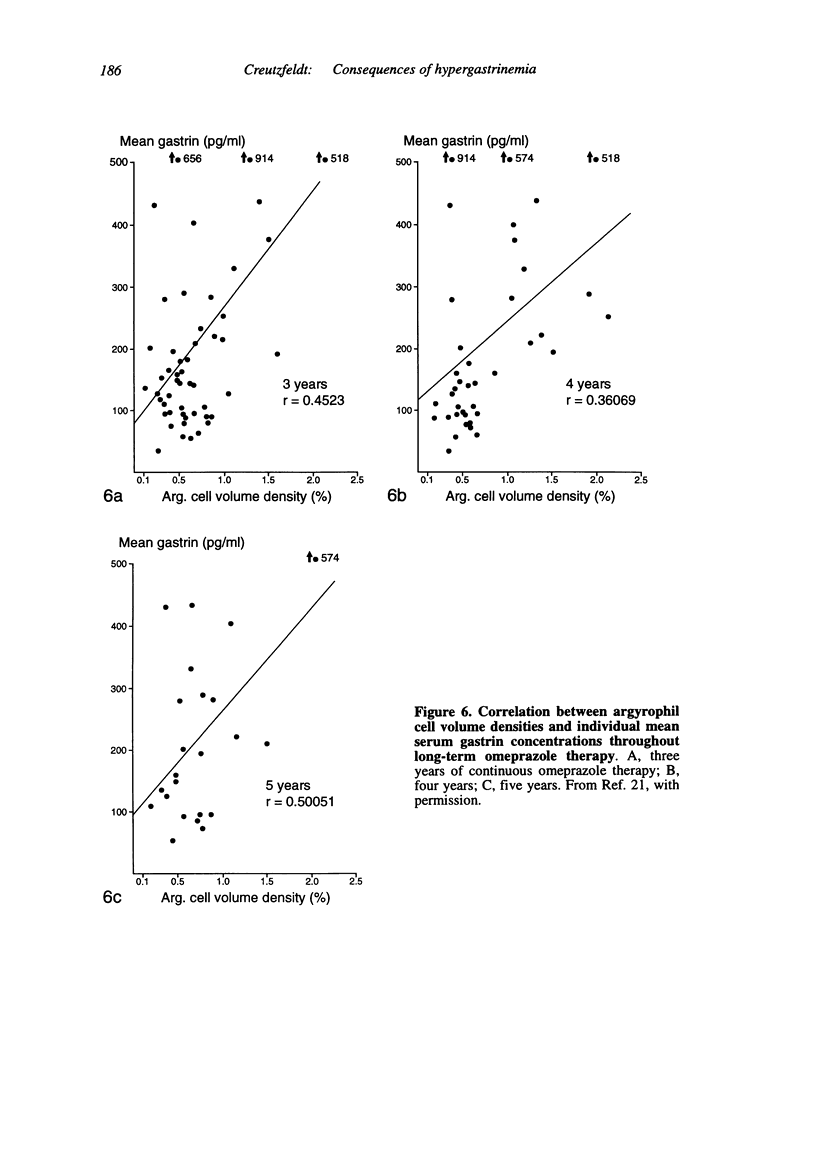
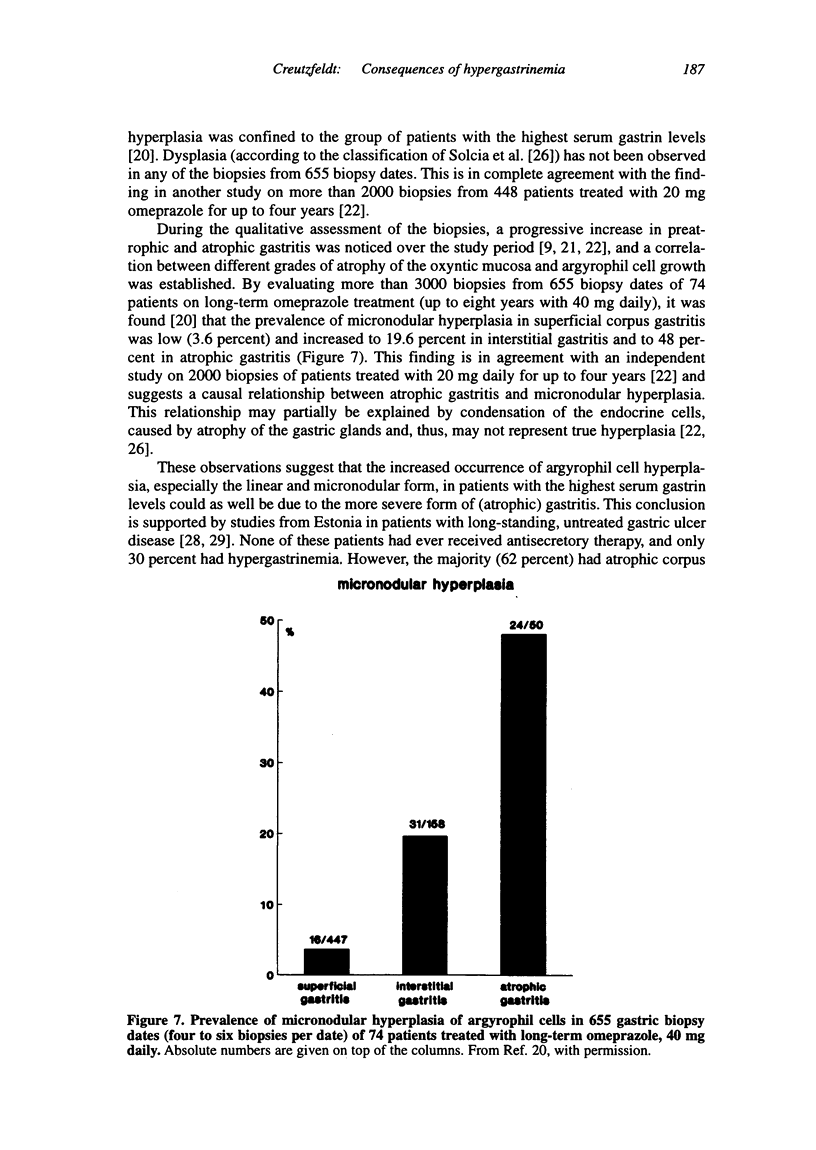
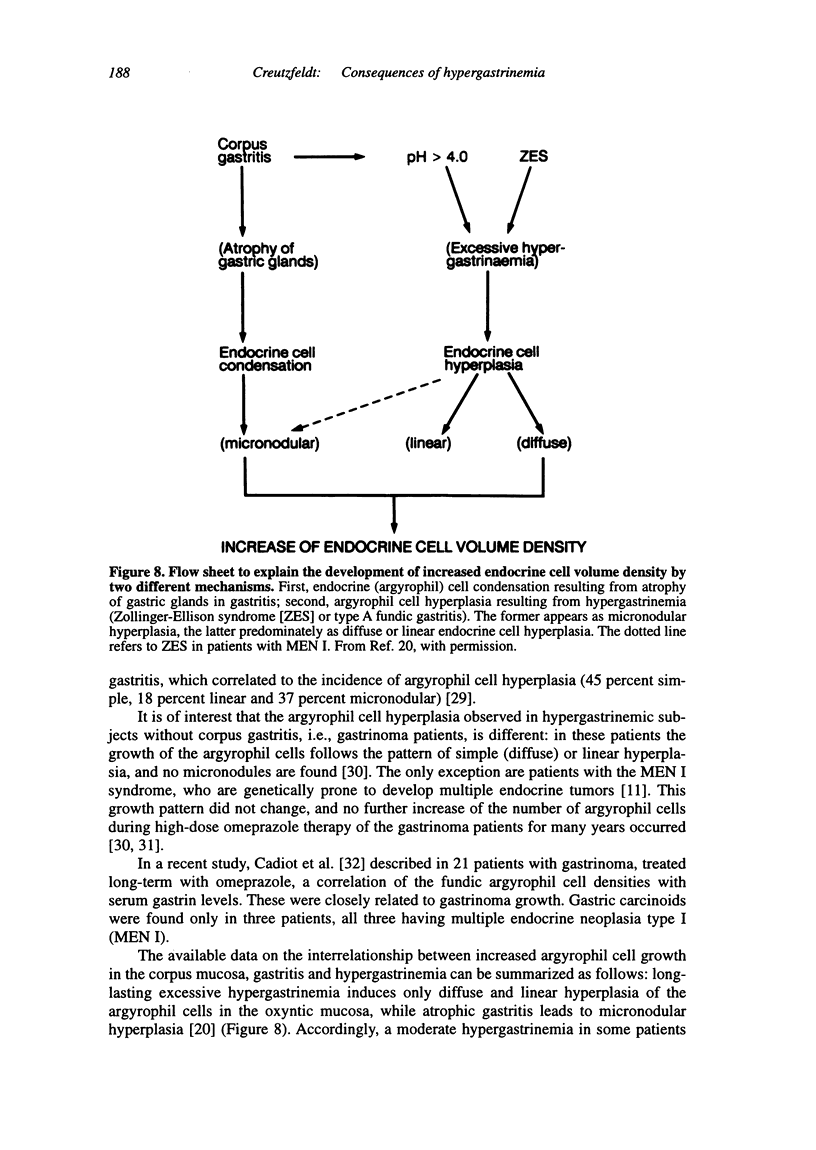
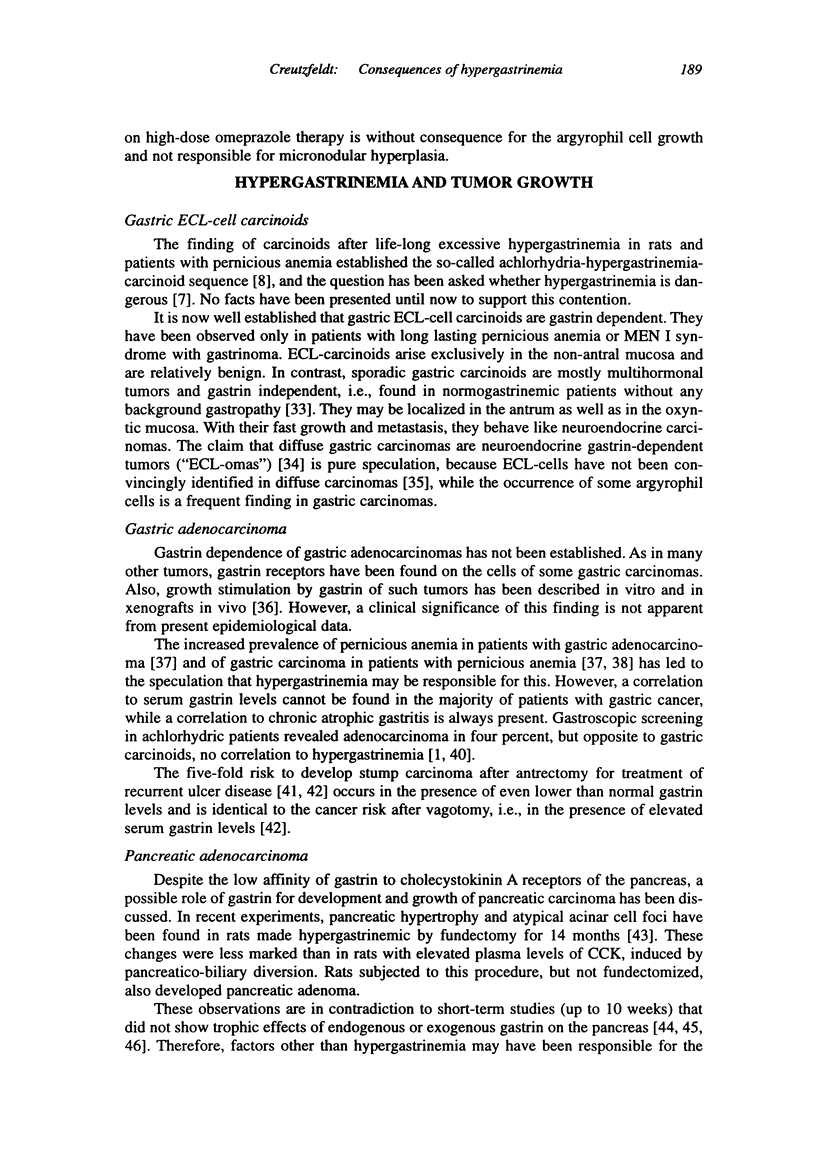
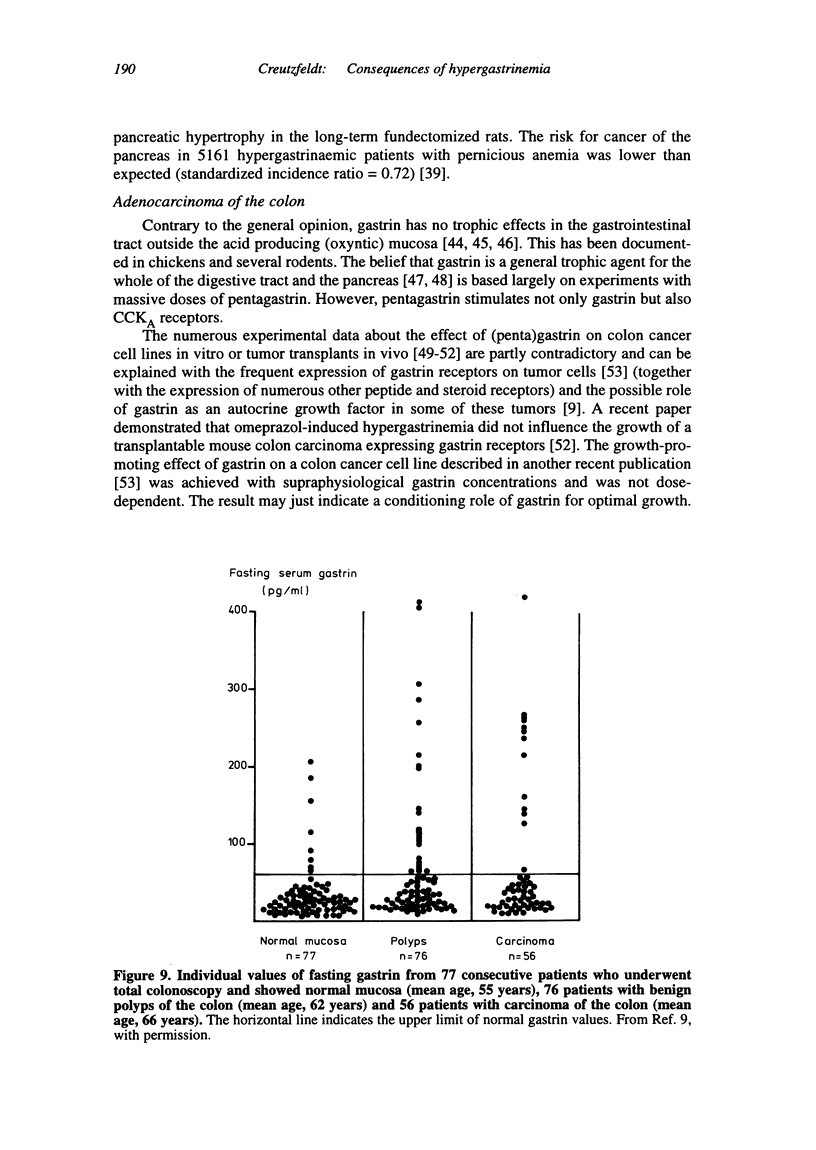
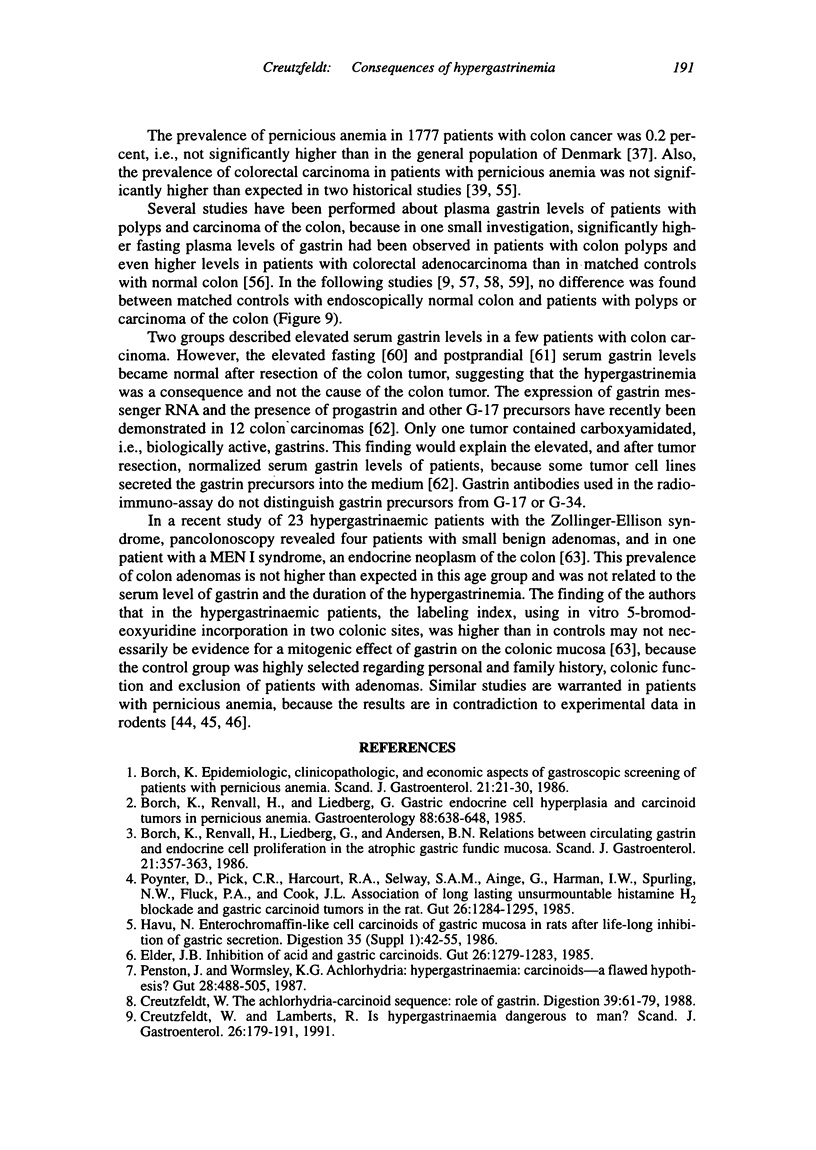
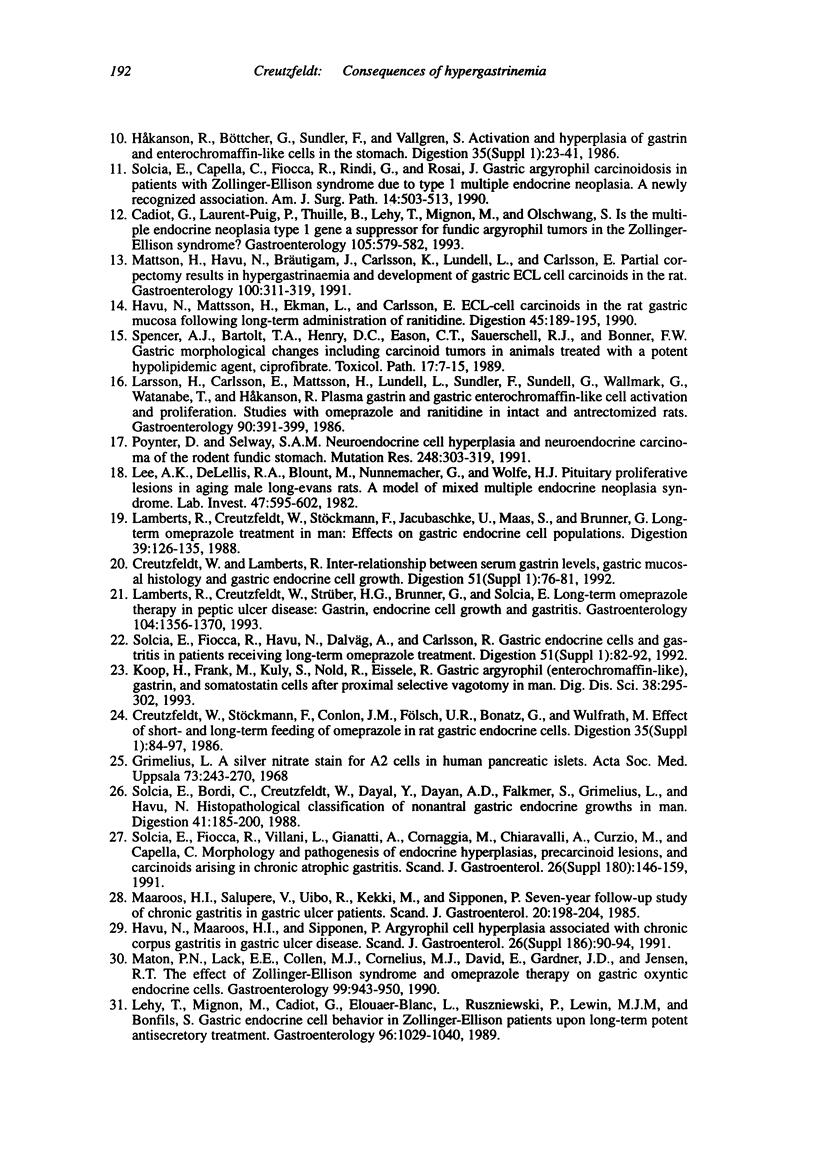
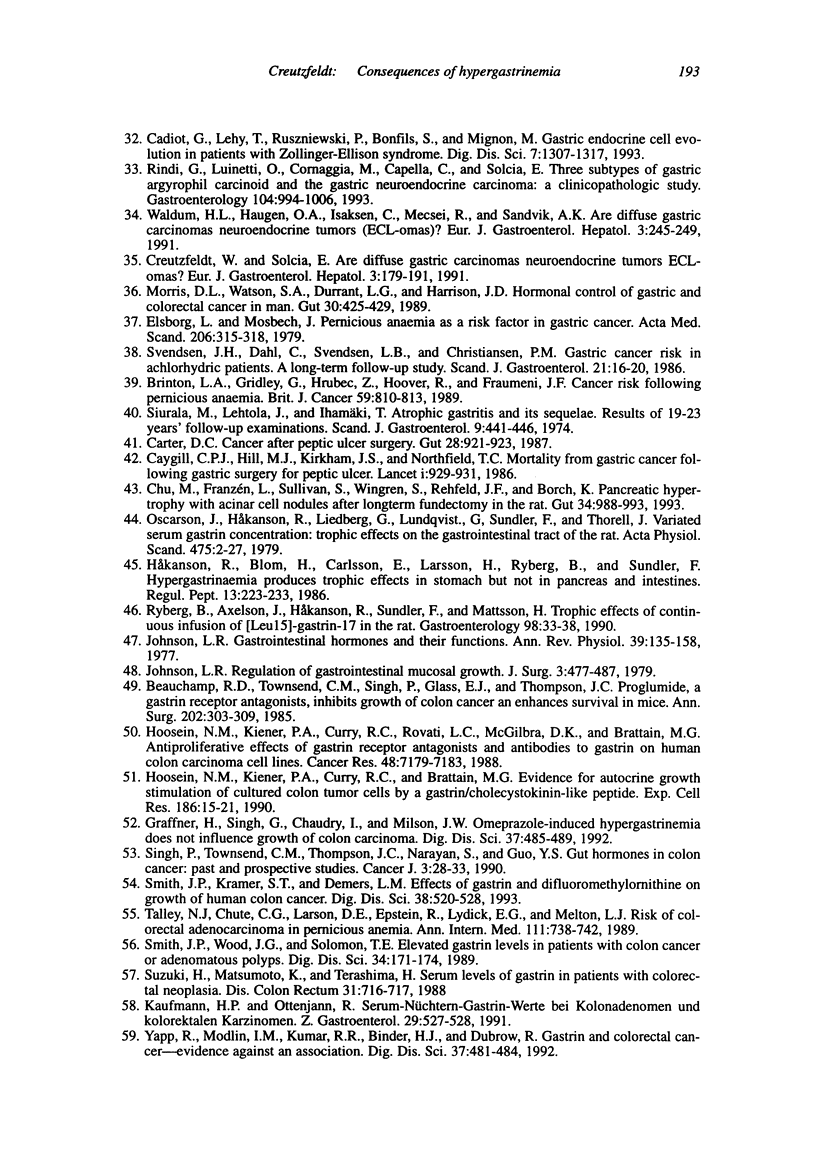
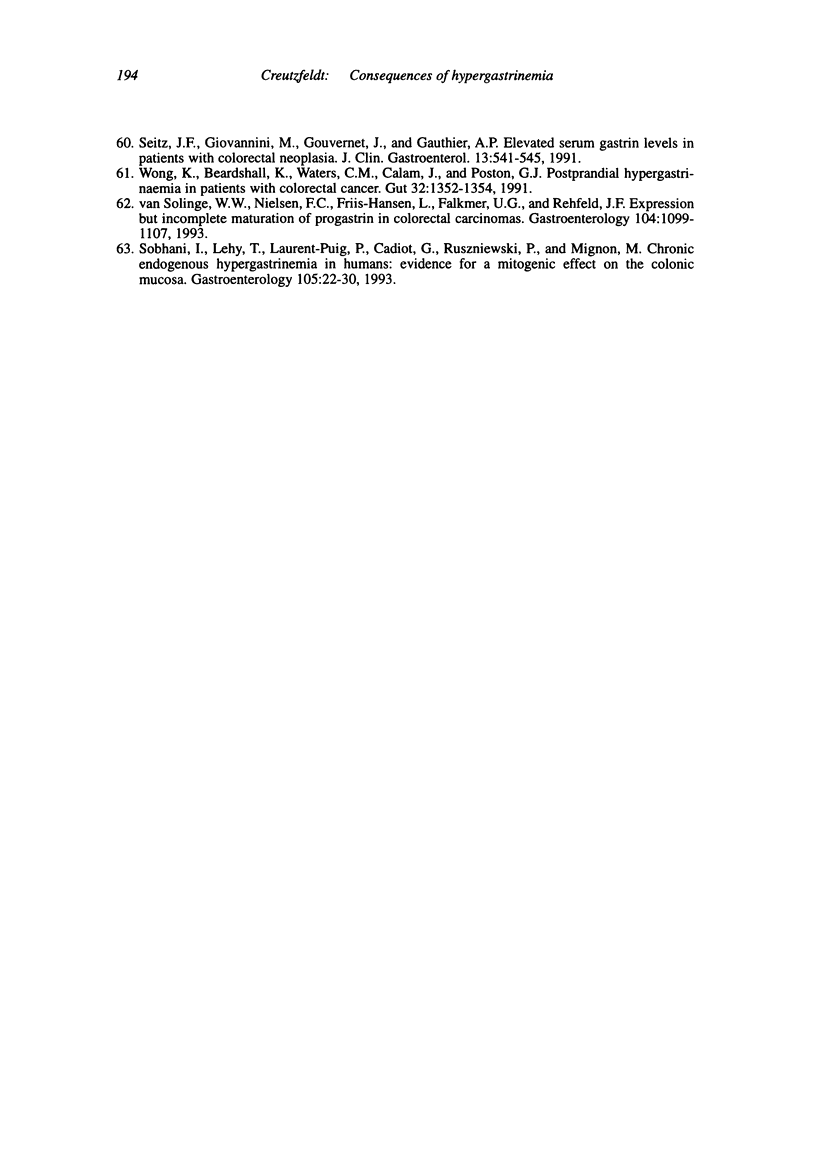
Selected References
These references are in PubMed. This may not be the complete list of references from this article.
- Beauchamp R. D., Townsend C. M., Jr, Singh P., Glass E. J., Thompson J. C. Proglumide, a gastrin receptor antagonist, inhibits growth of colon cancer and enhances survival in mice. Ann Surg. 1985 Sep;202(3):303–309. doi: 10.1097/00000658-198509000-00005. [DOI] [PMC free article] [PubMed] [Google Scholar]
- Borch K. Epidemiologic, clinicopathologic, and economic aspects of gastroscopic screening of patients with pernicious anemia. Scand J Gastroenterol. 1986 Jan;21(1):21–30. doi: 10.3109/00365528609034616. [DOI] [PubMed] [Google Scholar]
- Borch K., Renvall H., Liedberg G., Andersen B. N. Relations between circulating gastrin and endocrine cell proliferation in the atrophic gastric fundic mucosa. Scand J Gastroenterol. 1986 Apr;21(3):357–363. doi: 10.3109/00365528609003087. [DOI] [PubMed] [Google Scholar]
- Borch K., Renvall H., Liedberg G. Gastric endocrine cell hyperplasia and carcinoid tumors in pernicious anemia. Gastroenterology. 1985 Mar;88(3):638–648. doi: 10.1016/0016-5085(85)90131-3. [DOI] [PubMed] [Google Scholar]
- Brinton L. A., Gridley G., Hrubec Z., Hoover R., Fraumeni J. F., Jr Cancer risk following pernicious anaemia. Br J Cancer. 1989 May;59(5):810–813. doi: 10.1038/bjc.1989.169. [DOI] [PMC free article] [PubMed] [Google Scholar]
- Cadiot G., Laurent-Puig P., Thuille B., Lehy T., Mignon M., Olschwang S. Is the multiple endocrine neoplasia type 1 gene a suppressor for fundic argyrophil tumors in the Zollinger-Ellison syndrome? Gastroenterology. 1993 Aug;105(2):579–582. doi: 10.1016/0016-5085(93)90736-v. [DOI] [PubMed] [Google Scholar]
- Cadiot G., Lehy T., Ruszniewski P., Bonfils S., Mignon M. Gastric endocrine cell evolution in patients with Zollinger-Ellison syndrome. Influence of gastrinoma growth and long-term omeprazole treatment. Dig Dis Sci. 1993 Jul;38(7):1307–1317. doi: 10.1007/BF01296083. [DOI] [PubMed] [Google Scholar]
- Carter D. C. Cancer after peptic ulcer surgery. Gut. 1987 Aug;28(8):921–923. doi: 10.1136/gut.28.8.921. [DOI] [PMC free article] [PubMed] [Google Scholar]
- Caygill C. P., Hill M. J., Kirkham J. S., Northfield T. C. Mortality from gastric cancer following gastric surgery for peptic ulcer. Lancet. 1986 Apr 26;1(8487):929–931. doi: 10.1016/s0140-6736(86)91041-x. [DOI] [PubMed] [Google Scholar]
- Chu M., Franzén L., Sullivan S., Wingren S., Rehfeld J. F., Borch K. Pancreatic hypertrophy with acinar cell nodules after longterm fundectomy in the rat. Gut. 1993 Jul;34(7):988–993. doi: 10.1136/gut.34.7.988. [DOI] [PMC free article] [PubMed] [Google Scholar]
- Creutzfeldt W., Lamberts R. Inter-relationship between serum gastrin levels, gastric mucosal histology and gastric endocrine cell growth. Digestion. 1992;51 (Suppl 1):76–81. doi: 10.1159/000200920. [DOI] [PubMed] [Google Scholar]
- Creutzfeldt W., Lamberts R. Is hypergastrinaemia dangerous to man? Scand J Gastroenterol Suppl. 1991;180:179–191. doi: 10.3109/00365529109093198. [DOI] [PubMed] [Google Scholar]
- Creutzfeldt W., Stöckmann F., Conlon J. M., Fölsch U. R., Bonatz G., Wülfrath M. Effect of short- and long-term feeding of omeprazole on rat gastric endocrine cells. Digestion. 1986;35 (Suppl 1):84–97. doi: 10.1159/000199384. [DOI] [PubMed] [Google Scholar]
- Creutzfeldt W. The achlorhydria-carcinoid sequence: role of gastrin. Digestion. 1988;39(2):61–79. doi: 10.1159/000199609. [DOI] [PubMed] [Google Scholar]
- Elder J. B. Inhibition of acid and gastric carcinoids. Gut. 1985 Dec;26(12):1279–1283. doi: 10.1136/gut.26.12.1279. [DOI] [PMC free article] [PubMed] [Google Scholar]
- Elsborg L., Mosbech J. Pernicious anaemia as a risk factor in gastric cancer. Acta Med Scand. 1979;206(4):315–318. doi: 10.1111/j.0954-6820.1979.tb13517.x. [DOI] [PubMed] [Google Scholar]
- Graffner H., Singh G., Chaudry I., Milsom J. W. Omeprazole-induced hypergastrinemia does not influence growth of colon carcinoma. Dig Dis Sci. 1992 Apr;37(4):485–489. doi: 10.1007/BF01307567. [DOI] [PubMed] [Google Scholar]
- Grimelius L. A silver nitrate stain for alpha-2 cells in human pancreatic islets. Acta Soc Med Ups. 1968;73(5-6):243–270. [PubMed] [Google Scholar]
- Havu N. Enterochromaffin-like cell carcinoids of gastric mucosa in rats after life-long inhibition of gastric secretion. Digestion. 1986;35 (Suppl 1):42–55. doi: 10.1159/000199381. [DOI] [PubMed] [Google Scholar]
- Havu N., Maaroos H. I., Sipponen P. Argyrophil cell hyperplasia associated with chronic corpus gastritis in gastric ulcer disease. Scand J Gastroenterol Suppl. 1991;186:90–94. doi: 10.3109/00365529109103993. [DOI] [PubMed] [Google Scholar]
- Havu N., Mattsson H., Ekman L., Carlsson E. Enterochromaffin-like cell carcinoids in the rat gastric mucosa following long-term administration of ranitidine. Digestion. 1990;45(4):189–195. doi: 10.1159/000200245. [DOI] [PubMed] [Google Scholar]
- Hoosein N. M., Kiener P. A., Curry R. C., Brattain M. G. Evidence for autocrine growth stimulation of cultured colon tumor cells by a gastrin/cholecystokinin-like peptide. Exp Cell Res. 1990 Jan;186(1):15–21. doi: 10.1016/0014-4827(90)90204-n. [DOI] [PubMed] [Google Scholar]
- Hoosein N. M., Kiener P. A., Curry R. C., Rovati L. C., McGilbra D. K., Brattain M. G. Antiproliferative effects of gastrin receptor antagonists and antibodies to gastrin on human colon carcinoma cell lines. Cancer Res. 1988 Dec 15;48(24 Pt 1):7179–7183. [PubMed] [Google Scholar]
- Håkanson R., Blom H., Carlsson E., Larsson H., Ryberg B., Sundler F. Hypergastrinaemia produces trophic effects in stomach but not in pancreas and intestines. Regul Pept. 1986 Feb;13(3-4):225–233. doi: 10.1016/0167-0115(86)90041-8. [DOI] [PubMed] [Google Scholar]
- Håkanson R., Böttcher G., Sundler F., Vallgren S. Activation and hyperplasia of gastrin and enterochromaffin-like cells in the stomach. Digestion. 1986;35 (Suppl 1):23–41. doi: 10.1159/000199380. [DOI] [PubMed] [Google Scholar]
- Johnson L. R. Gastrointestinal hormones and their functions. Annu Rev Physiol. 1977;39:135–158. doi: 10.1146/annurev.ph.39.030177.001031. [DOI] [PubMed] [Google Scholar]
- Johnson L. R. Regulation of gastrointestinal mucosal growth. World J Surg. 1979 Aug 31;3(4):477–486. doi: 10.1007/BF01556110. [DOI] [PubMed] [Google Scholar]
- Kaufmann H. P., Ottenjann R. Serum-Nüchtern-Gastrin-Werte bei Kolonadenomen und kolorektalen Karzinomen. Z Gastroenterol. 1991 Oct;29(10):527–528. [PubMed] [Google Scholar]
- Koop H., Frank M., Kuly S., Nold R., Eissele R., Rager G., Rüschoff J., Rothmund M., Arnold R. Gastric argyrophil (enterochromaffin-like), gastrin, and somatostatin cells after proximal selective vagotomy in man. Dig Dis Sci. 1993 Feb;38(2):295–302. doi: 10.1007/BF01307547. [DOI] [PubMed] [Google Scholar]
- Lamberts R., Creutzfeldt W., Strüber H. G., Brunner G., Solcia E. Long-term omeprazole therapy in peptic ulcer disease: gastrin, endocrine cell growth, and gastritis. Gastroenterology. 1993 May;104(5):1356–1370. doi: 10.1016/0016-5085(93)90344-c. [DOI] [PubMed] [Google Scholar]
- Lamberts R., Creutzfeldt W., Stöckmann F., Jacubaschke U., Maas S., Brunner G. Long-term omeprazole treatment in man: effects on gastric endocrine cell populations. Digestion. 1988;39(2):126–135. doi: 10.1159/000199615. [DOI] [PubMed] [Google Scholar]
- Larsson H., Carlsson E., Mattsson H., Lundell L., Sundler F., Sundell G., Wallmark B., Watanabe T., Håkanson R. Plasma gastrin and gastric enterochromaffinlike cell activation and proliferation. Studies with omeprazole and ranitidine in intact and antrectomized rats. Gastroenterology. 1986 Feb;90(2):391–399. doi: 10.1016/0016-5085(86)90938-8. [DOI] [PubMed] [Google Scholar]
- Lee A. K., DeLellis R. A., Blount M., Nunnemacher G., Wolfe H. J. Pituitary proliferative lesions in aging male Long-Evans rats. A model of mixed multiple endocrine neoplasia syndrome. Lab Invest. 1982 Dec;47(6):595–602. [PubMed] [Google Scholar]
- Lehy T., Mignon M., Cadiot G., Elouaer-Blanc L., Ruszniewski P., Lewin M. J., Bonfils S. Gastric endocrine cell behavior in Zollinger-Ellison patients upon long-term potent antisecretory treatment. Gastroenterology. 1989 Apr;96(4):1029–1040. doi: 10.1016/0016-5085(89)91620-x. [DOI] [PubMed] [Google Scholar]
- Maaroos H. I., Salupere V., Uibo R., Kekki M., Sipponen P. Seven-year follow-up study of chronic gastritis in gastric ulcer patients. Scand J Gastroenterol. 1985 Mar;20(2):198–204. doi: 10.3109/00365528509089657. [DOI] [PubMed] [Google Scholar]
- Maton P. N., Lack E. E., Collen M. J., Cornelius M. J., David E., Gardner J. D., Jensen R. T. The effect of Zollinger-Ellison syndrome and omeprazole therapy on gastric oxyntic endocrine cells. Gastroenterology. 1990 Oct;99(4):943–950. doi: 10.1016/0016-5085(90)90611-4. [DOI] [PubMed] [Google Scholar]
- Mattsson H., Havu N., Bräutigam J., Carlsson K., Lundell L., Carlsson E. Partial gastric corpectomy results in hypergastrinemia and development of gastric enterochromaffinlike-cell carcinoids in the rat. Gastroenterology. 1991 Feb;100(2):311–319. doi: 10.1016/0016-5085(91)90197-s. [DOI] [PubMed] [Google Scholar]
- Morris D. L., Watson S. A., Durrant L. G., Harrison J. D. Hormonal control of gastric and colorectal cancer in man. Gut. 1989 Apr;30(4):425–429. doi: 10.1136/gut.30.4.425. [DOI] [PMC free article] [PubMed] [Google Scholar]
- Oscarson J., Håkanson R., Liedberg G., Lundqvist G., Sundler F., Thorell J. Variated serum gastrin concentration: trophic effects on the gastrointestinal tract of the rat. Acta Physiol Scand Suppl. 1979;475:2–27. [PubMed] [Google Scholar]
- Penston J., Wormsley K. G. Achlorhydria: hypergastrinaemia: carcinoids--a flawed hypothesis? Gut. 1987 Apr;28(4):488–505. doi: 10.1136/gut.28.4.488. [DOI] [PMC free article] [PubMed] [Google Scholar]
- Poynter D., Pick C. R., Harcourt R. A., Selway S. A., Ainge G., Harman I. W., Spurling N. W., Fluck P. A., Cook J. L. Association of long lasting unsurmountable histamine H2 blockade and gastric carcinoid tumours in the rat. Gut. 1985 Dec;26(12):1284–1295. doi: 10.1136/gut.26.12.1284. [DOI] [PMC free article] [PubMed] [Google Scholar]
- Poynter D., Selway S. A. Neuroendocrine cell hyperplasia and neuroendocrine carcinoma of the rodent fundic stomach. Mutat Res. 1991 Jun;248(2):303–319. doi: 10.1016/0027-5107(91)90064-u. [DOI] [PubMed] [Google Scholar]
- Rindi G., Luinetti O., Cornaggia M., Capella C., Solcia E. Three subtypes of gastric argyrophil carcinoid and the gastric neuroendocrine carcinoma: a clinicopathologic study. Gastroenterology. 1993 Apr;104(4):994–1006. doi: 10.1016/0016-5085(93)90266-f. [DOI] [PubMed] [Google Scholar]
- Ryberg B., Axelson J., Håkanson R., Sundler F., Mattsson H. Trophic effects of continuous infusion of [Leu15]-gastrin-17 in the rat. Gastroenterology. 1990 Jan;98(1):33–38. doi: 10.1016/0016-5085(90)91287-g. [DOI] [PubMed] [Google Scholar]
- Seitz J. F., Giovannini M., Gouvernet J., Gauthier A. P. Elevated serum gastrin levels in patients with colorectal neoplasia. J Clin Gastroenterol. 1991 Oct;13(5):541–545. doi: 10.1097/00004836-199110000-00013. [DOI] [PubMed] [Google Scholar]
- Siurala M., Lehtola J., Ihamäki T. Atrophic gastritis and its sequelae. Results of 19-23 years' follow-up examinations. Scand J Gastroenterol. 1974;9(5):441–446. [PubMed] [Google Scholar]
- Smith J. P., Kramer S. T., Demers L. M. Effects of gastrin and difluoromethylornithine on growth of human colon cancer. Dig Dis Sci. 1993 Mar;38(3):520–528. doi: 10.1007/BF01316509. [DOI] [PubMed] [Google Scholar]
- Smith J. P., Wood J. G., Solomon T. E. Elevated gastrin levels in patients with colon cancer or adenomatous polyps. Dig Dis Sci. 1989 Feb;34(2):171–174. doi: 10.1007/BF01536047. [DOI] [PubMed] [Google Scholar]
- Sobhani I., Lehy T., Laurent-Puig P., Cadiot G., Ruszniewski P., Mignon M. Chronic endogenous hypergastrinemia in humans: evidence for a mitogenic effect on the colonic mucosa. Gastroenterology. 1993 Jul;105(1):22–30. doi: 10.1016/0016-5085(93)90006-x. [DOI] [PubMed] [Google Scholar]
- Solcia E., Bordi C., Creutzfeldt W., Dayal Y., Dayan A. D., Falkmer S., Grimelius L., Havu N. Histopathological classification of nonantral gastric endocrine growths in man. Digestion. 1988;41(4):185–200. doi: 10.1159/000199786. [DOI] [PubMed] [Google Scholar]
- Solcia E., Capella C., Fiocca R., Rindi G., Rosai J. Gastric argyrophil carcinoidosis in patients with Zollinger-Ellison syndrome due to type 1 multiple endocrine neoplasia. A newly recognized association. Am J Surg Pathol. 1990 Jun;14(6):503–513. doi: 10.1097/00000478-199006000-00001. [DOI] [PubMed] [Google Scholar]
- Solcia E., Fiocca R., Havu N., Dalväg A., Carlsson R. Gastric endocrine cells and gastritis in patients receiving long-term omeprazole treatment. Digestion. 1992;51 (Suppl 1):82–92. doi: 10.1159/000200921. [DOI] [PubMed] [Google Scholar]
- Solcia E., Fiocca R., Villani L., Gianatti A., Cornaggia M., Chiaravalli A., Curzio M., Capella C. Morphology and pathogenesis of endocrine hyperplasias, precarcinoid lesions, and carcinoids arising in chronic atrophic gastritis. Scand J Gastroenterol Suppl. 1991;180:146–159. doi: 10.3109/00365529109093193. [DOI] [PubMed] [Google Scholar]
- Spencer A. J., Barbolt T. A., Henry D. C., Eason C. T., Sauerschell R. J., Bonner F. W. Gastric morphological changes including carcinoid tumors in animals treated with a potent hypolipidemic agent, ciprofibrate. Toxicol Pathol. 1989;17(1 Pt 1):7–15. doi: 10.1177/01926233890171P102. [DOI] [PubMed] [Google Scholar]
- Suzuki H., Matsumoto K., Terashima H. Serum levels of gastrin in patients with colorectal neoplasia. Dis Colon Rectum. 1988 Sep;31(9):716–717. doi: 10.1007/BF02552592. [DOI] [PubMed] [Google Scholar]
- Svendsen J. H., Dahl C., Svendsen L. B., Christiansen P. M. Gastric cancer risk in achlorhydric patients. A long-term follow-up study. Scand J Gastroenterol. 1986 Jan;21(1):16–20. doi: 10.3109/00365528609034615. [DOI] [PubMed] [Google Scholar]
- Talley N. J., Chute C. G., Larson D. E., Epstein R., Lydick E. G., Melton L. J., 3rd Risk for colorectal adenocarcinoma in pernicious anemia. A population-based cohort study. Ann Intern Med. 1989 Nov 1;111(9):738–742. doi: 10.7326/0003-4819-111-9-738. [DOI] [PubMed] [Google Scholar]
- Van Solinge W. W., Nielsen F. C., Friis-Hansen L., Falkmer U. G., Rehfeld J. F. Expression but incomplete maturation of progastrin in colorectal carcinomas. Gastroenterology. 1993 Apr;104(4):1099–1107. doi: 10.1016/0016-5085(93)90279-l. [DOI] [PubMed] [Google Scholar]
- Wong K., Beardshall K., Waters C. M., Calam J., Poston G. J. Postprandial hypergastrinaemia in patients with colorectal cancer. Gut. 1991 Nov;32(11):1352–1354. doi: 10.1136/gut.32.11.1352. [DOI] [PMC free article] [PubMed] [Google Scholar]
- Yapp R., Modlin I. M., Kumar R. R., Binder H. J., Dubrow R. Gastrin and colorectal cancer. Evidence against an association. Dig Dis Sci. 1992 Apr;37(4):481–484. doi: 10.1007/BF01307566. [DOI] [PubMed] [Google Scholar]


